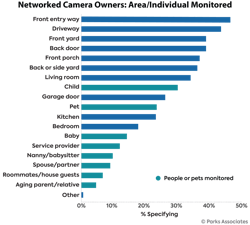This article originally appeared in the June 2022 issue of Security Business magazine. When sharing, don’t forget to mention Security Business magazine on LinkedIn and @SecBusinessMag on Twitter.
As product capabilities grow, new monitoring services beyond security are expanding, including proactive defense through video analytics, personal emergency response systems (PERS) enhancements, energy usage monitoring, and securing valuable assets such as vehicles and yard equipment.
Integration between video, access control, and home automation services will continue to flourish in the years to come and an empathetic approach to innovation will help the security industry deliver the benefits consumers value most.
It Starts with Control
Consumers have a variety of options for home control: self-installed DIY systems like SmartThings; pro-installed systems offered by security services like ADT Pulse or Brinks, with Alarm.com technology; or custom whole-home systems like Control4 or Crestron. Consumers can also create smart home control through individual devices with cloud-to-cloud integrations that do not rely on traditional hardware controllers, like Amazon Alexa, Google Home, Works with Nest, and various API integrations.
As smart home control continues to evolve, consumers can anticipate that new capabilities will emerge. Predictive analytics and machine learning could help create better experiences in the smart home by learning family habits, household patterns, and individual preferences – and using that intelligence to create automation sequences.
Machine learning will be able to adjust personal settings as the occupant’s behavior changes over time or other contextual factors come into play, such as time of year, day of the week, presence of others in the home, or weather conditions. Additionally, push notifications – information-based suggestions – may cause nudges (action-based suggestions derived from previous behaviors), leading to true automation after the user has affirmed certain courses of action or preferences.
Further, one unified app could offer critical consumer control, with 86% of smart home device owners wanting a single unified app to control all smart home devices.
Analytics Extend Coverage Beyond the Door; Reduces False Alarms
Video analytics play a significant role in residential security video surveillance technology and require greater bandwidth, lower latency, and 24/7 connectivity. The induction of video analytics in modern video surveillance solutions can help detect and deter potential criminal activity, reduce false alarms, and accommodate touchless solutions.
There is an excellent opportunity for security providers to build on their core offerings by extending security all the way from inside the home to the perimeter of a property. A key benefit of video analytics in the security space is providing a more personalized user experience with more intelligent alerts.
False alerts caused by simple motion detection can frustrate users by generating a high volume of notifications due to harmless triggers, such as wind or shadows, leading users to disable or ignore alerts. Parks Associates’ research reveals that 48% of US security system owners with broadband internet at home agree that their home security system triggers too many false alarms, and 39% strongly agree.
Many advanced AI applications deployed for commercial security services, including video analytics and machine learning, are trickling down to residential customers and helping to address these frustrations. Leveraged by network camera manufacturers, video analytics can have major service implications, including home delivery, in-store shopping, authentication, and more. The firm reports that sales of networked cameras, video doorbells, and smart speakers/smart displays will reach 250 million units in 2024. This growing technology can identify people, objects, animals, packages, license plates, and other subjects of interest visible in video camera feeds to interpret the meaning and context of their presence near or in the home.
Automated notifications reduce delays, while advanced sensors can provide more accurate and comprehensive data to first responders. Recent data provided by Parks Associates demonstrates that this is a growing interest among home security service subscribers. Additionally, 25% of home security system owners or purchase intenders in U.S. broadband households ranked video verification to reduce false alerts and expedite first responder dispatch among their top three desired security system features, a slight increase from 23% in 2020.
On average, security system owners report experiencing more than three false alarms in a year, commonly caused by pets triggering a motion sensor, a smoke detector activating, and low or dead batteries in the system or an attached device. False alarms can also result in fees for security owners ranging from $25-250 per incident, and responses to false alarms have been estimated to cost local police departments billions annually.
Both system owners and monitoring stations can benefit from video analytics by using the provided visual information to aid their assessment of whether the alarm requires an emergency response – reducing response for false alarms and promoting more rapid response for verified alarms.
Jennifer Kent is Vice President of Research for market research firm Parks Associates (www.parksassociates.com). This is an excerpt from the Parks Associates complimentary whitepaper, Value Beyond Home Security: Expanding Product Ecosystems, in collaboration with Alarm.com. Available at https://parksassociates.com/whitepapers/beyondsecurity-wp2021, this research highlights the expansion of professional services beyond home security – driven by the growth of connected devices, new technology, and unified offerings from professional service providers and DIY solutions.



